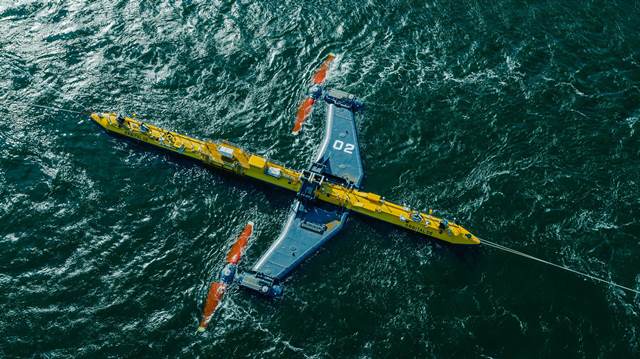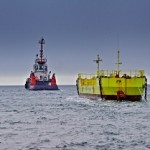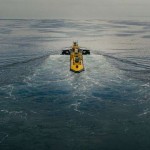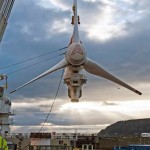Press release: UK Government backs tidal power

Orbital O2 tidal turbine – design in Orkney, built in Dundee and being demonstrated at EMEC (Credit Orbital Marine Power)
The UK Government has announced its biggest investment in a generation into tidal power, kickstarting a new chapter for the UK’s tidal energy industry.
The UK Government will invest £20 million per year across the UK in tidal stream electricity as part of its flagship renewable energy auction scheme. This will strengthen energy security by adding to our diverse, renewable electricity supply and create jobs across the UK’s coastal communities.
Today’s investment in tidal energy further demonstrates the UK’s commitment to build a strong, home-grown renewable energy sector to reduce our reliance on volatile fossil fuels.
As part of the fourth allocation round of the Contracts for Difference Scheme due to open next month, the UK Government will ensure that £20 million per year will be ringfenced for tidal stream energy projects, giving the marine energy sector a chance to develop their technology and lower their costs in a similar way to the offshore wind industry. This will bring the total funding for this allocation round to £285 million per year UK wide.
Commenting on the announcement, EMEC’s managing director, Neil Kermode said:
“This support for the marine energy industry is absolutely pivotal – our work here at EMEC to demonstrate new technology is world-leading, but there must be a domestic market to ensure wave and tidal stream technologies can reach commercialisation and play their part in our future energy mix, right here in our own waters.
“Support for the first large arrays of tidal stream projects is an incredibly positive signal for investment in marine renewable energy – I want to thank the numerous Ministers, MPs and civil servants who were convinced by the case we put forward, and understood the potential benefits to our economy, environment, and exports this new industry can bring.”
Scotland has long been a pioneer for tidal technology having been home to the European Marine Energy Centre (EMEC) in Orkney since 2003 where tidal energy technologies are demonstrated at sea. The UK has the largest tidal stream deployment in the world, with almost 50% of the world’s installed tidal stream capacity in Scottish waters. Furthermore, this year Simec Atlantis Energy Ltd, a homegrown company used their expertise to export and install a tidal turbine – designed and built in Scotland – for piloting in Japan.
Over time marine energy technologies have the potential to significantly contribute to the UK’s decarbonisation commitments and will support hundreds of green jobs across the country, with projects currently in development in North-West Scotland, North Wales and the Southern coast of England.
Tidal energy has the potential to be a very reliable source of generation, given the clockwork predictability of the tides. Including this in the UK’s low-carbon energy mix will make it easier to match supply with demand, building on the UK Government’s commitment to build a strong, home-grown renewable energy sector to reduce the reliance on fossil fuels and exposure to volatile global gas prices.
Business and Energy Secretary Kwasi Kwarteng said:
“As an island nation we are perfectly placed to capitalise on clean marine energy, building on our booming offshore wind sector which is now a British industrial success story.
“We hope to see marine energy follow in the successful footprints of other renewable technologies, where we’ve seen costs fall dramatically in recent years thanks to UK government support.
“The investment today provides a major push for tidal power to become a key part of the next generation of renewable electricity projects needed to strengthen energy security as we work to reduce our dependency on volatile fossil fuels.”
Scottish Secretary Alister Jack said:
“This UK Government allocation of funding for the tidal industry in Scotland, and across the UK, is tremendous news. Harnessing the powers of our seas is a vital step in our transition to the use of greener, cleaner energy and underlines the UK Government’s commitment to create and protect highly-skilled jobs while on our journey to Net Zero by 2050.
“With strong wind and solar power industries in the UK it is the natural next step to explore our tidal energy capabilities. It’s an exciting development in supporting of our domestically-produced renewable energy sources.”
Full details of all Contracts for Difference scheme announcements will be released on Thursday 25 November where the UK Government will outline plans to launch the biggest ever Contracts for Difference (CfD) allocation round, with this new ringfencing for tidal stream expected to bring the total budget for the fourth allocation to £285 million per year.
The CfD scheme is the Government’s primary method of encouraging investment in low-carbon electricity. The scheme has helped to deliver substantial new investment and reductions in the costs of capital for some renewable technologies, such as helping to reduce the price of offshore wind by 65%.
This fourth round of the Contracts for Difference Scheme will open on 13 December 2021. The UK Government will launch this auction process with the ambition of supporting up to 12 GW low-carbon electricity capacity – more than the last three rounds combined.
The costs continue to fall as green technology advances, with solar and wind now cheaper than existing coal and gas power plants in most of the world. This is thanks to clear government signals and investment made ahead and during the COP26 climate change summit, along with targeted support that boosts private sector investment, creates high-quality jobs and builds industries and technology as the UK builds back greener from the pandemic.
Energy Minister Greg Hands, said:
“The development of Scotland’s renewables industry is a major UK success story, with our renewable energy auction scheme playing a vital role in the UK becoming a world leader in clean electricity generation and helping to bring down prices for consumers.
“Today’s dedicated backing for tidal stream power is opening up a new chapter for Britain’s coastal communities and advancing the possibilities for Britain’s marine energy sector to play a significant role in delivering the UK’s green industrial revolution”.
Orkney and Shetland MP, Alistair Carmichael, said:
“This is excellent news and a testament to the tireless campaign by so many people to get the government on side. This is a success that has been years in the making and has the potential to set up tidal stream energy commercialisation – with green growth and jobs in the isles and across the UK – for the years to come.
“I have to pay tribute to Neil Kermode and the team at EMEC in Orkney and Andrew Scott and Orbital Marine in Orkney, amongst many others in the isles and beyond, like Sue Barr of the Marine Energy Council, who have worked in concert to make the case for tidal stream energy. By making a full-court press in support of tidal stream – demonstrating that this was not just a hypothetical but a fully-developed business case – they converted sceptics across government to our team.
“These are the green technologies of the future. By leading in their development and deployment now then we can reap the benefits in the years to come. Putting fiscal support behind these proven technologies was a no-brainer and I am glad that the government now agrees.
“I could quibble over the exact amount given – and of course there will be a great deal of work to be done to get this support into action – but now it is time to recognise a genuine win for the isles and for the country. This is an enormous opportunity for our economy and our environment – and now we can take it.”
Chair of the UK Marine Energy Council, Sue Barr, said:
“The impact of this support cannot be overstated. Here in the UK we have the knowledge, skills, people and projects to lead the world in marine energy, but we have been missing a vital piece of the puzzle to unlock investment and allow the sector to scale-up and deliver. The marine energy sector stretches the length and breadth of the UK – from the Isle of Wight to Orkney and Shetland.
“This dedicated ringfence will secure our domestic market, support decarbonisation and will enable tidal stream energy to develop; delivering export opportunities, green jobs, and economic growth in the process. We are grateful to Ministers and the broader UK Government for having listened, understood and acted. This new support for tidal stream brings us one step closer to delivering a Great British success story that will provide both environmental benefits through the generation of renewable energy alongside UK-wide supply chain benefits.”
Source: UK Government
Further details:
- Contracts for Difference (CfD) contracts are allocated through a competitive auction process where the cheapest projects in each technology group are awarded contracts first, with the auction designed to ensure competitive pressure to keep costs down and protect consumers
- The fourth CfD round aims to increase the capacity of renewable electricity awarded contracts from the 5.8GW achieved in the last round to around 12GW.
- Renewable projects are subject to strict planning controls that afford protections to local communities and the environment and guidance will ensure communities are engaged with and are able to benefit from renewable infrastructure in their area.
- CfDs give greater certainty and stability of revenues to electricity generators by reducing their exposure to volatile wholesale prices, while protecting consumers from paying for higher costs when electricity prices are high.
- The £20 million additional ringfenced budget is for Tidal Stream projects, not Tidal Range (which is a different technology). Tidal Range projects are not eligible to enter into the CfD scheme.
- The £20 million Tidal Stream ringfenced budget, and the £285 million total figure, are presented in 2011/12 prices in line with the Control for Low Carbon Levies. These figures are an estimate of annual support in the most expensive year in the first four years following deployment. Actual annual figures will vary over the 15 year lifetime of the contract depending on future wholesale electricity prices, and outcomes of the competitive auction process.
- More information on how the Contracts for Difference scheme operates can be found here: How does the CfD work?








